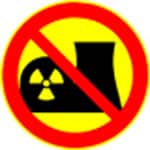Nuclear Fuel Cycle – Cycle of Pollution
A Cycle of Deadly Pollution
The Nuclear Fuel Cycle – Cycle of Pollution
Just as the use of coal plants implies coal mining, the use nuclear power plants implies uranium mining and the rest of the “fuel cycle.” The fuel cycle of nuclear power requires several steps. It starts with the mining of uranium ore which is then milled using both physical and chemical means. The milled ore is then converted to nuclear fuel by a process called “enrichment,” which is followed by fabrication into fuel pellets. These fuel pellets are placed into long metal fuel rods, suitable for being inserted into a nuclear reactor. During their use in the reactor, the fission process creates many other radioactive isotopes as the fuel pellets lose their ability to react and generate the heat that is turned into electricity. That is, they become “spent.” The then spent fuel rods are temporarily stored in “spent fuel pools” — essentially large swimming pools next to the reactor — awaiting the next step. Each of these steps pollutes the environment by releasing radioactivity in one form or another.
Waste Storage
For decades, we have been told that this high-level nuclear waste would be stored deep underground where it would pose no threat for the quarter million years it will remain dangerous. (Plutonium 239, one of the products created by fissioning uranium, has a half-life of 24,100 years. This means that half of a given sample will “decay” in that amount of time. The time required for radioactive material to become “safe” is generally agreed to be 10 half-lives. Ten half-lives of plutonium total 240,000 years.) To date, neither the federal government nor the industry has created such a storage facility. Instead, all the waste that has been produced by all US nuclear power plants currently resides in spent fuel pools near the reactors that produced it. These unprotected pools contain over five times as much radioactive material as is in all U.S. reactor cores. It clearly presents a tempting target to terrorists. Indeed, four decades ago Australian physician Dr. Helen Caldecott warned that if one has a nuclear power plant, one’s enemy does not need a nuclear weapon.
Climate Change Risk
When the nuclear industry promotes its product as “clean energy” it means nuclear power plants don’t emit greenhouse gases while they are operating. This narrow definition ignores the fossil fuels used throughout the nuclear fuel cycle, as well as the other types of pollution they produce. As the U.S. Energy Information Administration points out:
If fossil fuels are used for mining and refining uranium ore, or if fossil fuels are used when constructing the nuclear power plant, then the emissions from burning those fuels could be associated with the electricity that nuclear power plants generate.
Unlike the really clean energy sources – wind and solar power – nuclear power discharges radioactive and chemical pollution to the air and water.
The nuclear fuel cycle also adds the prospect of increasing costs. Uranium’s price – like oil’s – is subject to the “market” and the risk of rising cost as it becomes more scarce and demand increases. In 2000 the price for uranium was $10 (per pound), in 2005 it went up to $140, by 2019 the price was down to $20 and in 2024, the price was at $97. If the nuclear industry has its way, it will mean a big increase in demand for uranium and that will result in ever-higher costs. Currently we are dependent on foreign suppliers, including Russia, for uranium fuel. But that would get even worse if the U.S. were to build new so-called “advanced” reactors because the only source of fuel for those reactors is Russia.
Continuing to invest in the dead-end that is nuclear power deprives us of substantial funds that could be better used to address climate change.
Below in the Resources section you will find papers, articles, videos, etc. documenting the nuclear fuel cycle.
• Working with other organization in the West to make sure consumers have safe, affordable, and reliable power.
• Reaching out to the Northwest residents make them aware that nuclear energy is not a viable climate action.
• Supporting the deployment of local energy sources that will keep electric rates affordable for all such as energy efficiency and solar.
Utilities in the Pacific Northwest are in the process of planning for reducing their carbon footprint and while some are looking at energy efficiency and conservation along with renewablea, others are unfortunately looking to nuclear power. It's important we encourage those utilities seeking nuclear free options to continue down that path. At the same time, we need to let those utilities planning on nuclear power know they need to follow a nuclear free path and focus on local energy projects. Nuclear power costs will only add significant costs to electric bills in addition to the increased costs for fixing the electric grid for reliability.
Action Needed Now!
Tell Your Electric Utility
Now is not the time to solve one problem with another, one that will increase electric rates and impact future generations with radioactive waste. Let your utility know you want your ratepayer dollars to be used for energy efficiency, community renewables, and rooftop solar. Here are the utilities that we know are considering new nuclear reactors:
Clark Public Utility District - Grant County Public Utility District - Pacific Power
Resources
Note: To expand the table go the bottom of the table and on the righthand corner click on "View larger version." For more help view the Document Library Guide.
